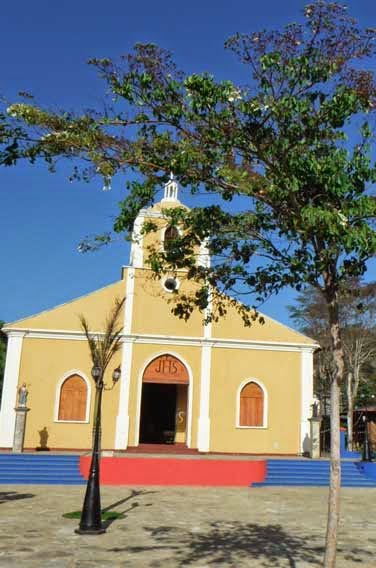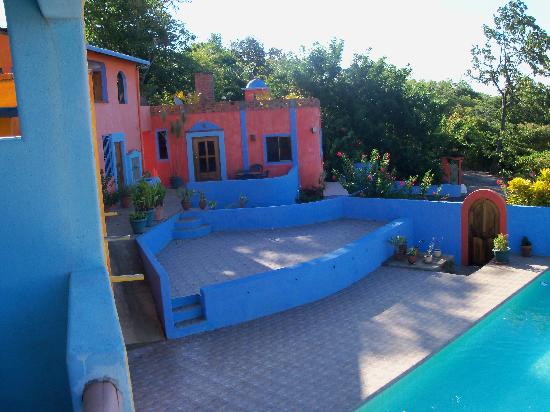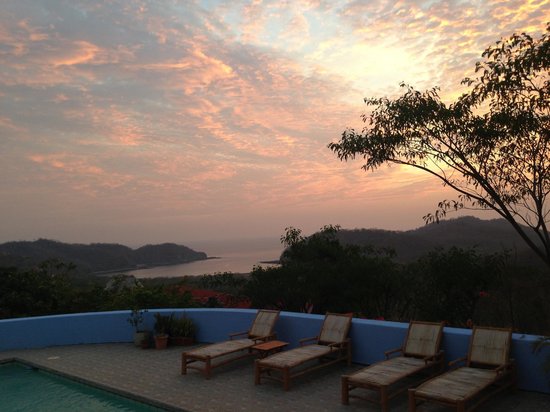 |
At the Costa Rican border.
|
The trip
back to Costa Rica was cheaper but also hotter and more complicated. The cab
picked us up at 8:00 a.m. and drove like hell down to the border. As in Costa
Rica, passing on curves is no problem in Nicaragua. The roads are better – the
road from San Juan Del Sur to the border actually had shoulders, white lines on
the edge and yellow lines down the center. Still, that would be little
consolation if your cab, while passing on the curve, smashed into an
18-wheeler. “I’m so happy I died on the nice
road,” you’d say at the first afterlife cocktail party.
The taxi
stopped at the border. There was no town here; simply a series of chain link
fences and low buildings blocking the highway. Under huge tropical trees, people
flowed in all different directions selling sandwiches, trinkets, cold drinks; hucksters
offered to change cordobas back to colones; young men were constantly trying to
grab your luggage and carry it for you. You have to be firm. Our driver pointed
to a break in a chain link fence about a hundred yards ahead and told us to go
through to customs. We wheeled our luggage across the steamy asphalt, until we
saw an official-looking person at a hole in the fence.
We showed
our passports to the official and finally allowed two pleasant, insistent young
men to take our bags to the correct window. They wore some kind of badges that
apparently allowed them to guide hapless tourists through the Nicaraguan
customs building. They showed us how to fill out the forms (here we paid the
clerk behind the desk $1 each – for the privilege of getting into the
building). The guys with the badges then led us to the next window. One of them
told us the inspector at that particular window was a good friend of his would
only charge us $2 each instead of $12. By that time we were pretty much
captives of the badge guys who were hanging onto our luggage, so we followed
them to the “special” window. The clerk behind the window charged us $2 each,
and handed us a receipt that said 3.20 (maybe in cordobas?).
We walked along
more asphalt with our two valets toward Costa Rican customs. One of them asked
me,” You like Costa Rica?” I said I did. He smiled. “La pura vida,” he said. I
replied “mas o meno,” and we had a good laugh. They stopped abruptly and told
us we would have to go on without them. We tipped them and some more for their
friend, the Nicaraguan agent behind the window.
Entering
Costa Rica was mostly a breeze. The line at the customs window was short. We
were a little worried that our passports would be questioned. They expire in
the middle of September, which meant at the end of March we were within six
months of expiration. We’d heard horror stories of entire families being turned
away at the airport in Costa Rica because their passports were too close to
being expired. The day before we left for Nicaragua, one of our friends had advised
us to make the appointment to renew our passports and print out the proof that
we were “in process.” The earliest appointment we could get was mid-April, but
we had the appointment paperwork with us just in case. But the
customs clerk only asked for proof that we had tickets out of Costa Rica, which
we did – for June 26 – 90 days away.
As we’ve written previously, until we
finish our residency, we’ll have to leave the country every 90 days. The clerk
stamped Paul’s passport first, writing in “60.” We’d heard this happens –
apparently the customs clerks have total discretion as to how much time they
will give you in country. On a blog we’d recently read that one family of five
had times from 15 to 90 days given them (apparently the clerk was having an “impura
vida” day). Marilyn grabbed Paul’s passport from the clerk, gave her back our
90-day departure ticket and pointed to the date. Without a word, the clerk
crossed out her original stamp, re-stamped the passport and wrote in “90,” then
stamped and wrote “90” on Marilyn’s passport as well.
Our next
stop was the luggage scanner and within moments we walked out into the humid
air and faced a happy jumble of human activity. Strolling policemen, families
sitting on the curbs with their luggage (there is no seating anywhere) pedi-cab
operators picking up and dropping off lost-looking travelers, waiting buses
with engines idling, exhaust fumes billowing, people munching on snacks, paper
wrappers and plastic bottles skittering over the road in search of a trash can.
 |
| Ticket kiosks - no bus for us! |
Lined up at
the curb were tiny ticket kiosks for different bus lines. They looked like hot
dog stands. We went to the Ticabus booth, since we had left San Jose on
Ticabus. The girl indicated that we could not get a bus to San Jose from her. She
pointed two hot dog stands down, repeating “roja, “roja” – a red-roofed
building with another tiny ticket booth attached to it. The girl in the tiny
ticket booth shook her head, and directed us inside.
 |
| The Deldu bus ticket building. |
Behind a
window, a clerk was selling bus tickets and bathroom passes (200 colones).
Confused, we thought this was the place to purchase all tickets, but it was only
for the Deldu bus. The tickets only cost about $9/each, compared to the $27
Ticabus tickets. We still haven’t figured out why couldn’t get a Ticabus or a
Nicabus ticket at the border; we saw people buying tickets, but had no idea
where they were going and why they could get tickets and we couldn’t.
 |
For 200 colones, you receive a handful of toilet paper and
are buzzed into the very secure restroom; a good idea
since there's no restroom on the Deldu bus. |
We killed an
hour and a half sitting on the curb waiting for our bus. Marilyn went to find
some food while I guarded our luggage. She and another Gringo (a young guy
heading back to the beach) hiked past an endless line of trucks waiting to
cross into Nicaragua. A row of buildings down a deep grade off the side of the
road looked promising, but when they got closer, none of them were food shops.
The guy
scrambled down the embankment to a car rental, scrambling back up with the
news, “There’s a place down there,” he said, pointing farther down the row of
trucks, “but they only sell sodas.” Marilyn explained that sodas are the tiny
restaurants that dot every Costa Rican town and road. Food!!
 |
| Deldu Bus |
The soda was
part of a massive truck stop nestled in the trees off the road. Marilyn and her
new pal eventually found the tiny shop and ordered jamon y queso sandwiches (ham
and cheese) and bought some chips and water. The young man sat down to eat his
sandwich immediately, so Marilyn headed back, locating me and our luggage on
the curb.
 |
| Guanacaste seems to have more horses than people. |
Soon we saw
what must have been our bus (it was the only one with the windows opened). The
interior was exactly the same as the Ticabus, except no restroom. We figured
that Deldu purchases the old Ticabuses and Nicabuses after the A/C and
bathrooms give out, but while the engine still has life left.
 |
| Dry Guanacaste |
At breakneck
speed with all the windows open the ride back was not as hot as we had feared.
It reminded us both of driving to the beach when we were kids and the only air
conditioning in the family car was wide-open windows. We stopped in little
towns and sometimes roadside bus stops in the country side as we made our way
south through the dusty brown landscape and bare trees of Guanacaste.
 |
| One of many small-town bus stops on the way home. |
We arrived
in Liberia, a moderately sized city of Costa Rica, large enough to have its own
airport and nicely paved streets. Clearly there were American expats here; many
signs were in English. By mid- afternoon we began to turn inland on the Pan
American Highway toward mountains and cooler temperatures. The name of this
thoroughfare is a bit of hyperbole; it is in fact a two lane paved road with no
allowance made for the semi-tractor trailers which often creep up the steep
inclines backing up traffic as far as the eye could see. The bus pulled into a
large cafeteria for “viente minutos” so that the passengers could use the
restrooms and purchase food. We bought cooling frosty shakes that were a
welcomed treat.
The cool
breezes at higher elevations were refreshing, and we were soon passing by San
Ramon, a Central Valley town about 45 minutes west of Grecia. Our tickets were
through to San Jose, but the bus would be passing right by Grecia on the way
there. I asked the bus driver if he could stop and let us off in Grecia. At
about 4 pm, he pulled over by the side of the highway and called “Grecia.” We
were still in the countryside at the edge of the Pan American Highway, but got
off. He unloaded our luggage. He then pointed to a bus stand across the
highway. We waited for a break in the traffic and made it across. In about
twenty minutes another bus picked us up and took us to downtown Grecia, where
we got one more bus to take us up the ridge to El Cajon, our little
mountainside barrio.
It was 6 pm.
We were totally exhausted but oh- so-happy to be home.






































